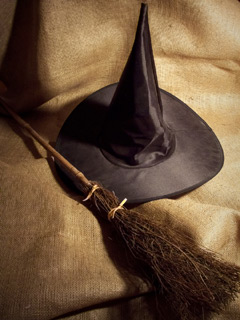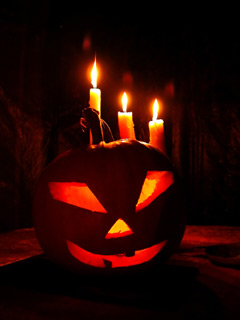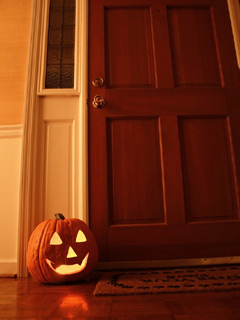|
|
|
Contrary to what some believe, Witchcraft, is a benevolent natured based religion who's roots can be traced back some 28,000
years. Witches do not worship the devil, in fact they don't even believe in the existence
of the devil. Their religion forbids the casting of harmful spells.
This religion and off-shoots of it exists today.
For more information be sure to read
The Origins of Halloween by
Rowan Moonstone.
The Ancient History of Halloween
 Halloween has
roots that extend back literally thousands of years among the
peoples of ancient Ireland, Scotland, England and France as
a religious festival. Halloween has
roots that extend back literally thousands of years among the
peoples of ancient Ireland, Scotland, England and France as
a religious festival.
Nature based religions that
typically worshiped both a God and a Goddess celebrated this
time as the end of the year, when the final crops were
brought in and the dark season of Winter began. Priests of these
religions would build sacred bonfires on hill tops and make
offerings to the deities in order to assure them an easy
winter and fruitful planting season for the next year. The
local people would hold celebrations with lots of food,
drink, dancing, and wear painted faces or fur and feathered
masks. Children would get treats such as sweets that they
normally wouldn't have during the year.
The Celts called this night
"Samhain" (pronounced: "sow-wan"). While
it was a festival for the years end it was also
believed that during this time the veil
between life and death was at its thinnest, allowing the dead
to return to earth. In order to keep unwanted spirits away,
they would hollow out a gourd or turnip and carve a scary
face into it then put a glowing coal inside and set it on
the ground by the front door for luck. This was also the
reason for wearing masks and painted faces.
When the Romans conquer the Celts
sometime during the 1st century A.D. they started trying to
convert them from their own religion to the Roman's religion. The
Celtic festival of Samhain fell
on the same days as the Roman celebration of the harvest,
Pomona, named for the Goddess Pomona who's symbol was the
apple. With the two cultures living together, the two
festivals merged into one, with the theme of apples and the
harvest becoming part of the annual festival of Samhain. As
time went by and the Romans converted to Christianity things
got a little troublesome.
The Changing of Samhain to
Halloween
 600's Century: Roman Catholicism had started to take over,
replacing he Gods and Goddesses of Celtic and Roman culture
with "the one God". One conversion technique was to try to
blend Catholic holidays with the Pagan ones to ease the
transition. Since the Pagan
celebration for Samhain was held on October 31st and November 1st, Pope Boniface
IV designated November 1st as All Saints' Day. On this day saints
and martyrs would be honored. Unfortunately for the Pope it
did not eliminate
the Pagan rituals as he had hoped. The people simply
celebrate both festivals together. 600's Century: Roman Catholicism had started to take over,
replacing he Gods and Goddesses of Celtic and Roman culture
with "the one God". One conversion technique was to try to
blend Catholic holidays with the Pagan ones to ease the
transition. Since the Pagan
celebration for Samhain was held on October 31st and November 1st, Pope Boniface
IV designated November 1st as All Saints' Day. On this day saints
and martyrs would be honored. Unfortunately for the Pope it
did not eliminate
the Pagan rituals as he had hoped. The people simply
celebrate both festivals together.
800's Century: Met with unsuccessful attempts to convert the
masses and trying to further erase the Pagan religions
Pope Gregory III ruled that All Saints' day was to fall on
the same day as Samhain. He declared that, in celebration of
the saints, young men would to go door to door begging for
food for the town poor and that villagers were allowed to
dress up in costume as saints. Thus, the eventual tradition
of trick-or-treating was born.
1500's: After 600 years of religious change the Roman
Catholics are finally getting rid of the last vestiges of
Pagan religions. Samhain and All Saints' Day have blended so well that
the old holiday is hardly recognizable and it's now called "All Hallows' Day".
Since it's still a two day celebration, the night before is
called "All Hallows' Evening". Eventually the villagers
blend the name together and it's called Hallow
Evening, or Halloween.
1600's: Roman Catholicism has split off into the Protestant
Church of England when King Henry VIII wants to divorce his
wife and creates his own church. The Catholics and
Protestants do not get along and much violence is caused by
this. Groups of people leave England by ship to come to the
Americas where they can practice religious freedom. The Puritans
landing in the New England states ban any holidays that they
consider to be Catholic in nature such as Halloween, Christmas,
and Easter. For the next 250 years, the very small
population of Catholics and
Episcopalians in America celebrate these holidays.
The Start of Halloween As We
Know It
 During the
1840's the sudden arrival of Irish Catholics to America
during the Irish Potato famine brings with it the Irish
Halloween traditions. The Irish discover an abundance of pumpkins
in the New World and decide to use them instead of turnips.
Carving a hollowed out pumpkin and carving it is much easier
than using turnips and gourds. The Jack-O-Lantern is born!! During the
1840's the sudden arrival of Irish Catholics to America
during the Irish Potato famine brings with it the Irish
Halloween traditions. The Irish discover an abundance of pumpkins
in the New World and decide to use them instead of turnips.
Carving a hollowed out pumpkin and carving it is much easier
than using turnips and gourds. The Jack-O-Lantern is born!!
During the
1860's members of both the Catholic and Episcopalian
churches campaign to put Halloween as an official holiday on
the official calendar. It was already officially sanctioned
by the churches and celebrated by some of the immigrants
from the U.K. and Ireland. Even though it would not count as
what was to be considered a "bank holiday" they wanted it
recognized just the same.
During the
1870's and from this time period on, Halloween began to gain a
real foothold in American society as it spread from
immigrants to people born in this country. It was during
this period that the idea of "tricks or treats" came to be as young people began using
Halloween night as an excuse to play mostly harmless pranks
on friends and neighbors.
In 1899, the Mankato Free Press reported that on Halloween "boys and
girls were reported out on the streets making a lot of noise
blowing horns and beating tin pans. They moved everything they could
find to a different spot and removed street signs." This is
the kind of harmless pranks that children and teens were
doing during this era. The "moving everything they could
find" usually entailed things like moving outhouses to other
locations, putting chairs and other easy to lift objects on
tops of houses.
Halloween Today
What Halloween has become today is very different
from it's humble beginnings as a religious celebration,
the vast majority of people celebrating it as a secular or
cultural holiday with no religious
connotations what so ever. Halloween in the United States and elsewhere continues to
grow in popularity with each passing year, becoming bigger and more
extravagant. People spend hundreds of dollars on costumes,
props and decorations for their home haunts, household
decorations, parties and professional haunts.
While it is still a religious
holiday for Neo-Pagans who, while enjoying it as a fun time
also take it very seriously, most people think of it as a
scary-cool holiday. It's because it's stress free, that they
dress in costume and can be what ever they want to be and
cut loose even for just one night a year.
|
Is
Halloween a holiday?
This would be answered based on your personal
definition of what a holiday is. The etymology of the
word "holiday", dating back pre-twelfth century, is
"holy" + "day", so it was certainly
considered a holy day
and still is by some people. We
consider Halloween to be a holiday because it is an
annual event that both individuals and family's
celebrate.
The
definition of "celebrate" at the Merriam-Webster Online
Dictionary is (in part):
"to observe a holiday, perform a
religious ceremony, or take part in a festival, to
observe a notable occasion with festivities."
Sounds
like a holiday to us! Now, if we could all just convince
the government to give everyone the day off like other
holidays! |
|
|
|